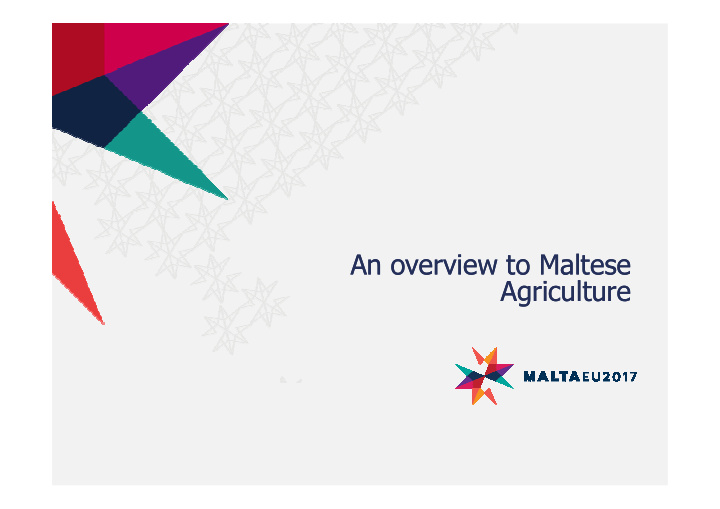



An overview to Maltese An overview to Maltese An overview to Maltese An overview to Maltese Agriculture Agriculture
Agriculture characteristics S mall holdings L imited resources and L and Fragmentation. 2
Maltese agriculture in figures • Utilisable agricultural area 11,689Ha • ±75% of agricultural holdings <1Ha • Number of holdings is 12,466 Number of holdings is 12,466 • 5,000Ha are sown annually in fodder 3
Maltese agriculture in figures • 100 pig farms, ±3,300sows, average 34 sows/farm. • 100 dairy cow farms, ±6,900cows, average 70 cows/farm • 590 ovi-caprine units having ≥5heads with a total of ±16,000 heads • 30 layer farms, rearing up to 300,000 birds • 60 broiler farms, slaughtered annually up to 2,230,000 birds 4
Strengths of the Maltese agriculture • Historically mild climatic conditions that permit multiple cropping multiple cropping • CAP assistance provides solidarity to agricultural operators • Generally all sectors have a short supply chain • Quality schemes are gaining momentum 5
Strengths in the Maltese agriculture. RDP measures promote sector innovation and modernisation Measure 1 – Knowledge transfer and information • actions actions Measure 2 – Advisory services, farm management and • farm relief services Measure 3 – Quality schemes for agricultural products • and foodstuffs Measure 4 – Investments in physical assets • Measure 6 – Farm and business development • Sub-measure 6.1 – business start-up aid for young farmers 6
Opportunities in Maltese Agriculture Direct Payments – Basic Payment – Greening Payment – Greening Payment – Priority to young farmers – Voluntary Coupled Support 7
Challenges – Small size • Lack economies of scale • Reliance on the importation of raw materials • Impaired export potential in lieu of the islands • Impaired export potential in lieu of the islands insularity 8
Challenges - Land fragmentation • High opportunity cost for agricultural land • Tenureship issues leading to financial limitations • Inaccessibility of parcels • Inaccessibility of parcels • Livestock farms with no farmland 9
Challenges – Limited resources • Ageing farming population • Resistance by the older generation to; hand over their hard earned business; accept over their hard earned business; accept innovative methods • Land abandonment especially in inaccessible areas • Difficulty for new entrants to join the sector 10
Challenges – Limited resources • Limited Water resources • Reliance on ground water • The acceptance of alternative water sources • The acceptance of alternative water sources • Soil characteristics 11
Emerging challenges Emerging challenges • The effects of Climate Change • Higher incidence of torrential rain followed by extended rain-less periods extended rain-less periods • Milder yet damper winters • Pests and disease are getting more resistant • No crop and livestock insurance is currently available. 12
Challenges encountered by agriculture operators in the Maltese islands. • Sector is primarily focused to meet the demand and supply of fresh produce demand and supply of fresh produce • Safety net mechanisms are most of the time impractical in the local context • Resistance by some sectors to join in a PO or a cooperative 13
Way forward • The updating of the national agricultural policy • Special focus on quality schemes • The re-opening of effective extension services • Investment in market research • Investment in market research • More effort to promote land consolidation • Emphasis on knowledge transfer and sharing 14
Thanks for your attention. 15
Recommend
More recommend